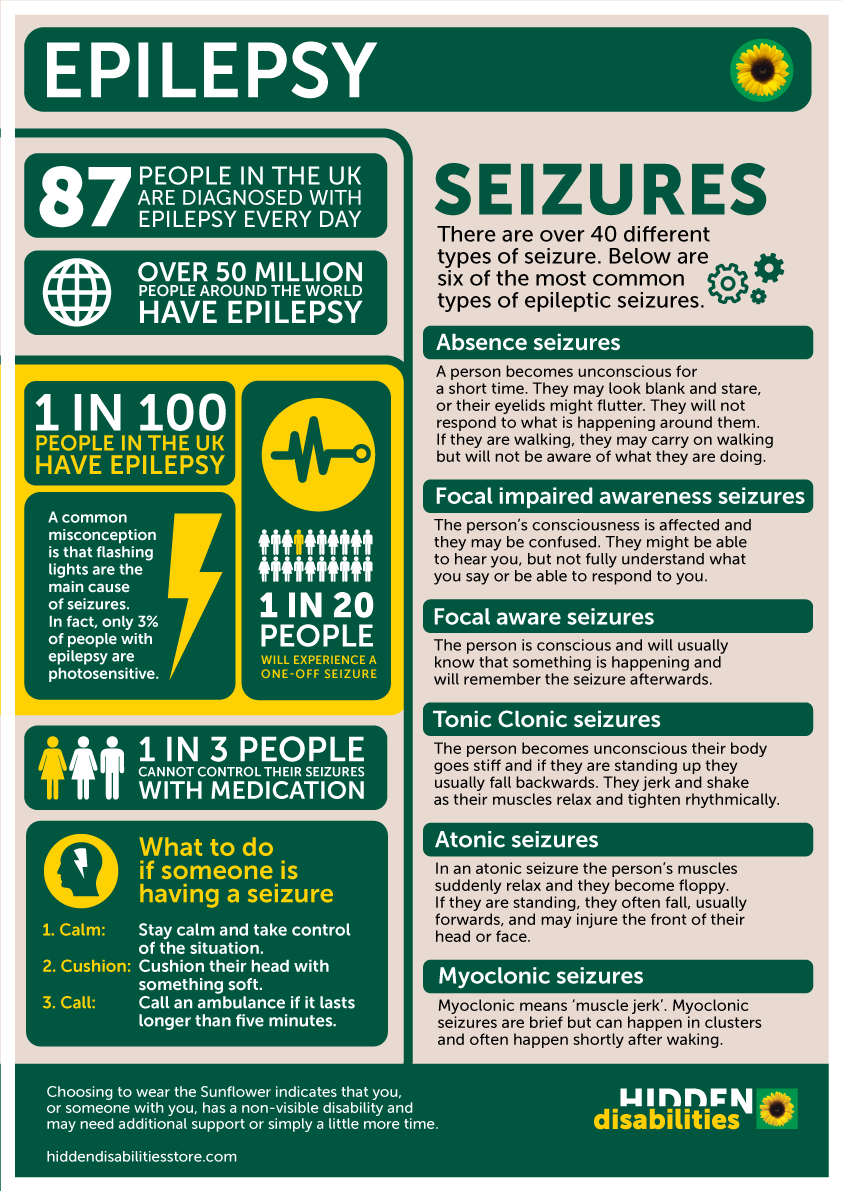Surprisingly little is known about the neurological condition epilepsy, even though there are over half a million people with the condition in the UK - that’s around 1 in 100 people! Over 50 million people around the world have epilepsy, making it one of the most common neurological conditions globally.
Most of us will be aware that epilepsy is a serious neurological condition affecting the brain and nervous system. You might also know that epileptic seizures are caused by a disturbance in the electrical activity of the brain. But you may not understand an awful lot more about the condition. Did you know for example, that there are over 40 different types of seizures and the causes and effects vary? Here we highlight five aspects of epilepsy that you may not know.

1. Not all seizures involve jerking or shaking movements. Some people seem vacant, wander around or are in a state of confusion during a seizure
Six of the most common types of epileptic seizures
Absence seizures are more common in children than adults and can happen very frequently. During an absence, a person becomes unconscious for a short time. They may look blank and stare, or their eyelids might flutter. They will not respond to what is happening around them. If they are walking, they may carry on walking but will not be aware of what they are doing.
In Focal Aware Seizures (FAS), previously called simple partial seizures, the person is conscious (aware and alert) and will usually know that something is happening and will remember the seizure afterwards.
Focal Impaired Awareness Seizures (FIAS) affect a bigger part of one hemisphere (side) of the brain than focal aware seizures. This seizure was previously called complex partial seizures.
Myoclonic seizures – Myoclonic means ‘muscle jerk’. Muscle jerks are not always due to epilepsy (for example, some people have them as they fall asleep). Myoclonic seizures are brief but can happen in clusters (many happening close together in time) and often happen shortly after waking.
In an atonic seizure (or 'drop attack') the person’s muscles suddenly relax and they become floppy. If they are standing, they often fall, usually forwards, and may injure the front of their head or face. Like tonic seizures, atonic seizures tend to be brief and happen without warning. With both tonic and atonic seizures people usually recover quickly, apart from possible physical injuries sustained.
Tonic Clonic Seizures - These are the seizures that most people think of as epilepsy. The person becomes unconscious their body goes stiff and if they are standing up they usually fall backwards. They jerk and shake as their muscles relax and tighten rhythmically.
To find out more about each type of seizure discussed above please visit the Epilepsy Society's website.
2. Flashing lights are often a trigger for an epileptic seizure, right? Wrong.
A common misconception is that flashing lights are the main cause of seizures. In fact, only 3% of people with epilepsy are photosensitive. Triggers that cause seizures can differ from person to person, but common reasons include tiredness and lack of sleep, stress, alcohol and not taking medication. For some people, if they know what causes their seizures, they may be able to avoid these triggers and so lessen the chances of having a seizure.
3. 1 in 20 people will experience a one-off seizure
Any one of us could potentially have a seizure at some point during our lives. This is not, however, the same as having epilepsy, which is a tendency to have seizures that start in the brain.
Seizures that are not due to epilepsy are sometimes called 'non-epileptic seizures'. They can have a physical cause, such as low blood sugar, or may be related to how the heart is working. Or they may have a psychological cause.
The most common type of non-epileptic seizures are dissociative seizures. Some non-epileptic seizures are caused by mental or emotional processes, rather than by a physical cause. This type of seizure may happen when someone's reaction to painful or difficult thoughts and feelings affects them physically.
4. 1 in 3 people cannot control their seizures with medication
Epilepsy is usually treated with medication called Anti-Epileptic Drugs (AEDs). AEDs aim to stop seizures from happening, but they do not cure epilepsy. With the right AEDs, up to 70% of people with epilepsy could have their seizures controlled (stopped).
For the remaining 30% of people who cannot control their seizures with AEDs, surgery may be an option. This can involve removing the part of their brain that causes the seizures, known as temporal lobe surgery. Around 70% of people who have temporal lobe surgery find that the procedure stops their seizures and they become seizure-free, and for a further 20% their seizures are reduced.
5. What to do if someone is having a seizure
Epilepsy is a non-visible condition until someone has a seizure. As you now know, some seizures are obvious, while others are not. Don’t assume that the person is drunk, and gently guide them away from any danger.
Please be kind, reassure them and stay with them until they recover.
Remember the 3 'C's
1. Calm - Stay calm
2. Cushion - Cushion their head
3. Call - Call 999.
For further information about epilepsy, access the epilepsy page in our invisible disabilities index.



